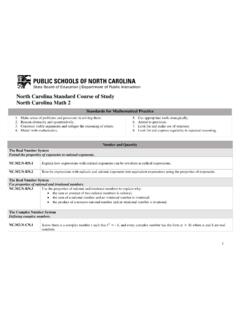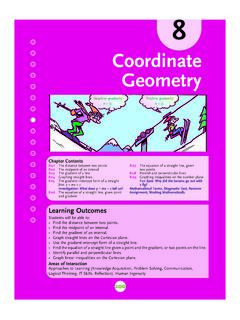Transcription of Georgia Standards of Excellence Curriculum Frameworks ...
1 These materials are for nonprofit educational purposes only. Any other use may constitute copyright infringement. Georgia Standards of Excellence Curriculum Frameworks GSE Third Grade Unit 4: Geometry Mathematics Georgia Department of Education Georgia Standards of Excellence Framework GSE Geometry Unit 4 Mathematics GSE Third Grade Unit 4: Geometry Richard Woods, State School Superintendent July 2018 Page 2 of 153 All Rights Reserved Table of Contents Overview ..3 Standards for Mathematical Practice ..5 Content Standards ..5 Big Ideas ..7 Essential Questions ..7 Concepts/Skills to Maintain ..7 Strategies for Teaching and Learning ..8 Selected Terms and Symbols ..11 Tasks ..12 Intervention Formative Assessment Lessons ..18 Show What You Know ..19 Move It Shape Sorter ..28 What Makes A Shape ..35 Properties of Quadrilaterals ..41 Can You Find It?
2 47 Score It ..51 Geoboard Geometry Guru ..60 Quadrilateral Riddles ..65 School Mosaic ..69 What Do You See?..78 What s The Connection? ..82 Pattern Block Fractions ..88 How Many Different Ways ..93 Picture Pie ..96 I Have, Who Has? ..102 A Whole Lot of Garden Hose ..108 Pentomino Perimeters ..113 Rectangles Rule ..119 How Big Is A Desk? ..124 Guess Who s Coming to Dinner? ..130 Measure My Shapes ..136 Pattern Block Graphing ..140 My Geometric Book ..145 Culminating Task Choice Board ..150 IF YOU HAVE NOT READ THE THIRD GRADE Curriculum OVERVIEW IN ITS ENTIRETY PRIOR TO USE OF THIS UNIT, PLEASE STOP AND CLICK HERE: Return to the use of this unit once you ve completed reading the Curriculum Overview. Thank you. Georgia Department of Education Georgia Standards of Excellence Framework GSE Geometry Unit 4 Mathematics GSE Third Grade Unit 4: Geometry Richard Woods, State School Superintendent July 2018 Page 3 of 153 All Rights Reserved OVERVIEW In this unit students will: Further develop understandings of geometric figures by focusing on identification and descriptions of plane figures based on geometric properties.
3 Identifies examples and non-examples of plane figures based on geometric properties. Identify differences among quadrilaterals. Understand that shapes in different categories may share attributes and those attributes can define a larger category (example: rhombuses, rectangles, and others have four sides and are all called quadrilaterals). Expand the ability to see geometry in the real world. Can draw plane figure shapes based on attributes. Further develop understanding of partitioning shapes into parts with equal areas. Partitions shapes in several different ways into equal parts of halves, thirds, fourths, sixths, and eighths and recognizes the partitioned parts have the same area. Use data collected to make bar and picture graphs. Interpret line plots. Find the perimeter of polygons; use addition to find perimeters; solve for an unknown length and recognize the patterns that exist when finding the sum of the lengths and widths of rectangles.
4 Third grade students will describe, analyze, and compare properties of two-dimensional shapes. They compare and classify shapes by their sides and angles, and connect these with definitions of shapes. Students also relate their fraction work to geometry by expressing the area of part of a shape as a unit fraction of the whole. Mathematically proficient students communicate precisely by engaging in discussion about their reasoning using appropriate mathematical language. Mathematically proficient students communicate clearly by engaging in discussion about their reasoning, using appropriate mathematical language. Students recognize area as an attribute of two-dimensional regions. They measure the area of a shape by finding the total number of same size square units required to cover the shape without gaps or overlaps. Students understand that rectangular arrays can be decomposed into identical rows or into identical columns.
5 By decomposing rectangles into rectangular arrays of squares, students connect area to multiplication, and justify using multiplication to determine the area of a rectangle. In second grade, students identify and draw triangles, quadrilaterals, pentagons, and hexagons. Third graders build on this experience and further investigate quadrilaterals (technology may be used during this exploration). Students recognize shapes that are and are not quadrilaterals by examining the properties of the geometric figures. They conceptualize that a quadrilateral must be a closed figure with four straight sides and begin to notice characteristics of the angles and the relationship between opposite sides. Students should be encouraged to provide details and use proper vocabulary when describing the properties of quadrilaterals. They sort geometric figures (see examples below) and identify squares, rectangles, and rhombuses as quadrilaterals*.
6 Georgia Department of Education Georgia Standards of Excellence Framework GSE Geometry Unit 4 Mathematics GSE Third Grade Unit 4: Geometry Richard Woods, State School Superintendent July 2018 Page 4 of 153 All Rights Reserved Students should classify shapes by attributes and by drawing shapes that fit specific categories. For example, parallelograms include: squares, rectangles, rhombi, or other shapes that have two pairs of parallel sides. Also, the broad category, quadrilaterals, includes all types of parallelograms, trapezoids and other four-sided figures. Students should also use this standard to help build on their understanding of fractions and area. Students are responsible for partitioning shapes into halves, thirds, fourths, sixths and eighths. Given a shape, students partition it into equal parts, recognizing that these parts all have the same area.
7 They identify the fractional name of each part and are able to partition a shape into parts with equal areas in several different ways. As an ongoing process throughout all third grade units, students should continue to develop understanding of representing and interpreting data using picture and bar graphs. They should also continue their work in generating measurement data by measuring lengths with rulers marked with halves and fourths of an inch. In second grade, students measured length in whole units using both metric and customary systems. It is important to review with students how to read and use a standard ruler including details about half and quarter marks on the ruler. Students should connect their understanding of fractions to measuring to one-half and one-quarter inch. Third graders need many opportunities measuring the length of various objects in their environment.
8 This standard provides a context for students to work with fractions by measuring objects to a quarter of an inch. With geometry, many student misconceptions might occur. The four content goals for geometry include shapes and properties, transformation, location, and visualization (see Van de Walle, page 205.) Students often have a difficult time recognizing shapes if the shape has been transformed by a translation, reflection, or rotation. Students may also identify a square as a non-rectangle or a non-rhombus based on limited images they see. They do not recognize that a square is a rectangle because it has all of the properties of a rectangle. They may list properties of each shape separately, but not see the interrelationships between the shapes. For example, students do not look at the properties of a square that are characteristic of other figures as well. Using straws to make four congruent figures have students change the angles to see the relationships between a rhombus and a square.
9 As students develop definitions for these shapes, relationships between the properties will be understood. Third grade should prepare students to be able to easily transition into fourth grade geometry. In fourth grade students will be required to draw points, lines, line segments, rays, angles (right, acute, obtuse), and perpendicular and parallel lines. Identify these in two-dimensional figures. Students in fourth grade will classify two-dimensional figures based on the presence or absence of parallel or perpendicular lines, or the presence or absence of angles of a specified size. Recognize right triangles as a category, and identify right triangles. Recognizing a line of symmetry for a two- Georgia Department of Education Georgia Standards of Excellence Framework GSE Geometry Unit 4 Mathematics GSE Third Grade Unit 4: Geometry Richard Woods, State School Superintendent July 2018 Page 5 of 153 All Rights Reserved dimensional figure as a line across the figure such that the figure can be folded along the line into matching parts will also be a part of fourth grade.
10 - Lesson for the teacher to learn more about teaching Geometry to elementary students. The lesson includes ideas for lessons, video of classrooms, etc. Standards FOR MATHEMATICAL PRACTICES (SMP) This section provides examples of learning experiences for this unit that support the development of the proficiencies described in the Standards for Mathematical Practice. The statements provided offer a few examples of connections between the Standards for Mathematical Practice and the content Standards of this unit. The list is not exhaustive and will hopefully prompt further reflection and discussion. Students are expected to: 1. Make sense of problems and persevere in solving them. Students make sense of problems involving the attributes of shapes. 2. Reason abstractly and quantitatively. Students demonstrate abstract reasoning about perimeters when considering the values of these numbers in relation to distance.













